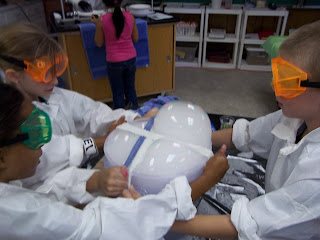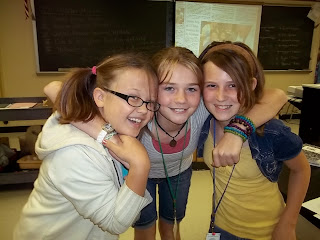ENIGMA DAY PHOTOS


The day started calmly when we had Mrs. Kim Strauss come to present a distance learning program through Texas Parks and Wildlife. "Urban Encounter: Awesome Opossums" taught us the many different characteristics and adaptations of our Texas Opossum. The favorite presentation was with Talking Tom and Talking Ben's News Program.What an awesome app for the iPad! Thanks, Kim!
 Enigma Day is a culminating activity in which the students share their PowerPoint presentations on the researched Enigma, such as the Loch Ness Monster, Bermuda Triangle, Marfa Lights or Atlantis! While parents are viewing their child's project they can also participate in several Mystery Science Activities in the CSI Science Lab!
Enigma Day is a culminating activity in which the students share their PowerPoint presentations on the researched Enigma, such as the Loch Ness Monster, Bermuda Triangle, Marfa Lights or Atlantis! While parents are viewing their child's project they can also participate in several Mystery Science Activities in the CSI Science Lab!



SLIME
Student Scientists mixed their own shaker cup of Slime to take home. Mixing of a PVA solution and a linking solution (Borax) forms the slime! Our superintendent, Mr. Sam Bell, even tried mixing his own batch of Slime.




GRAVI GOO
Another polymer activity was Gravi Goo. This mysterious substance seems to pour by itself. Some slipped away onto the floor which one of the visitors pointed out that must be how it got its name.:-)
It was great to see Mrs. Schwartz!


BOO BUBBLES
My son, Kyle, spent his lunch hour here at the lab. He was the Boo Bubble Scientist. The bubbles are formed from Carbon Dioxide Gas from dry ice and Joy dish soap. All you need is a Boo Bubble maker , water, soap, dry ice and Kyle. Mrs. Brinkmeyer liked Boo Bubbles, and she was pretty fond of the Gravi-Goo.






SCREAMING BALLOON
This is a lesson in sound. The hex nut makes a eerie sound when it spins inside the balloon. Mr. Ogg and Mr. Harrell check out the lab experiments!




RHEOSCOPE
Pearl Swirl makes a "rheoscope" which allows us to see the movement of currents. It is a nice model for abstract things we can't see such as ocean current, atmospheric movements and more.


JOURNAL ACTIVITY: GROWING BODY PARTS
Students traced the area of small polymer body parts to determine their size before we place them into water. They updated their Table of Contents and we will wait to see how the brain, nose, ear and hand grow in water over time.


GIANT CRYSTAL BALL BUBBLE
This was a favorite experiment. Fill water in a large bucket. Add dry ice. Mix Joy dish soap and use a piece of t-shirt to drag across the top rim of the bucket to form a bubble. The carbon dioxide forms a giant bubble on top of the bucket. Watch it pop to form a cool fog! Thanks, Mr. Shields for stopping by!

































